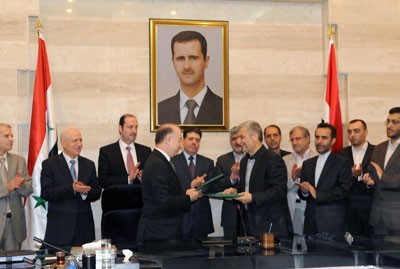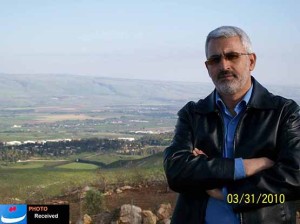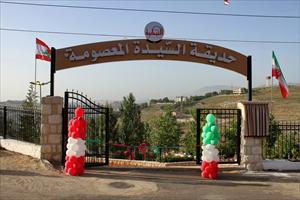Photo: Syrian and Iranian officials sign agreement over infrastructure, electricity, and aid
Amid reports — based on interviews with unidentified and unidentifiable “Iranian sources” — that Iran plans to send “4,000 Revolutionary Guards fighters” to help Assad’s forces, another, far more important story of Iranian influence and power in Syria is being overlooked and even dismissed.
That story does involve Tehran’s despatch to Syria of personnel of the Qods Force, the elite unit of the Islamic Revolutionary Guards Corps.
It does include Tehran’s attempts to increase its power and influence in Damascus.
What it does not feature, however, are “IRGC fighters”.
The important story is about Iran’s expanding reconstruction efforts in Syria — both to aid the Assad regime and to increase its own control and reach as part of its strategy of asymmetric warfare and diplomacy.
On Monday, Iran signed agreements with Syria to help Assad’s government rebuild electricity stations destroyed in the 27-month conflict.
At the ceremony, the Iranian Foreign Minister’s Special Advisor for Economic Affairs, Hassan Kazemi-Qomi — formerly Tehran’s Ambassador to Iraq — said that the Islamic Republic plans to carry out a range of development projects in Syria, including the buliding of flour mills and construction and reconstruction of electricity power plants.
Kazemi-Qomi also confirmed that Iran would extend a $3.5 billion line of credit, providing assistance with food stuff and energy supplies, to Syria
Syria has also exempted Iranian products from excise duty, to facilitate the flow of imports from the Islamic Republic.
Tehran’s initiative bolsters its ally Bashar al-Assad at a critical time, as temperatures rise this summer, electricity outages become more and more common, and food shortages grow.
Reconstruction Amid Unending Fighting
Reconstruction is a crucial part of the Assad regime’s strategy for winning over local hearts and minds and for gaining control on the ground. It is no coincidence that Syrian State media is emphasizing rebuilding efforts in al-Qusayr, the strategic town on the Lebanese border recaptured by Syrian forces on 5 June. The Syrian government is offering local people cash gifts of 100,000 SYP (about $800) each to return and recontstruct their homes. Damascus has also pledged to renew the town’s electricity, water and medical facilities — possibly with Iranian assistance.
Through such steps, the regime hopes to secure the town against incursions by insurgents and reduce the likelihood of local unrest caused by internal refugees. At the same time, the public efforts are aimed to win the lasting support of locals.
And For Iran?
There are several reasons why Tehran invests so much time and money in reconstruction projects, not only in Syria but in other countries in the region, including Lebanon, Iraq, and Afghanistan.
Reconstruction is central to Iran’s policy of “exporting the revolution” to regional countries via allied groups. ia the various groups it backs. Reconstruction is also part of Iran’s doctrine of “asymmetric” warfare —- which is far more than just a battlefield strategy.
Efforts in Lebanon, for example, have allowed the Islamic Republic to project its soft power and influence right up to Israel’s border. Through the Qods Force, the IRGC’s extraterritorial wing, Tehran has invested enormous sums into similar reconstruction projects in areas of southern Lebanon damaged in the Second Lebanon War in 2006, building not only homes but also infrastructure, gardens, mosques, and schools.
Is The Qods Force Really Involved In Reconstruction?
The importance of these projects, with a role for the Qods Force, has not only been overlooked by Western analysts — it has been dismissed as a “front” for more sinister, covert intelligence or military activities.
When Qods Force commander Hassan Shateri — the engineer in charge of the Iranian Committee for the Reconstruction of Lebanon (ICRL), whose role was to rebuild southern Lebanon in the wake of the 2006 Israeli-Hezbollah war — was killed en route from Damascus to Beirut earlier this year, Western analysts and reporters rushed to assert that he must have been involved in a military operation.
Shateri could not have been in Syria to survey reconstruction projects as Iran said, according to these observers. Instead, Western outlets — notably the American Enterprise Institute — suggested that Shateri must have been connected with a covert military operation, perhaps even involving Assad’s chemical weapons stores, the scare story of the day. (The issue of how a construction engineer could have advised Assad’s military elite on chemical weapons deployment was not addressed).
By seeking to impose a “spy story” on Shateri’s death and asserting that “reconstruction” was a poor cover for military activity, the Western media distorted our understanding of Iran’s operations in Syria and beyond.
Instead, a careful look at Iran’s treatment of Shateri’s death — or “martyrdom”, as the Islamic Republic framed it — sheds a great deal of light on just how important reconstruction is to Iran’s strategy of soft power projection and asymmetric warfare, in Syria as well as Lebanon.
The “martyr” Shateri — as Iran dubbed him after his death — led these efforts and represented Tehran’s political links with “the resistance” in both countries.
A BBC report this week highlighted the extent of Iran’s reconstruction activities in the southern Beirut suburb of al-Dahiyeh.
The reconstruction of al-Dahiyeh cost $400m, according to Hasan Jechi, the director of “Waed” (“Pledge”), the project set up after the 2006 war by Hezbollah to manage the reconstruction of the area.
Half of this amount was paid for by Iran, as was conceded by the Secretary General of Hezbollah, Sheikh Hassan Nasrallah.
“We consider the reconstruction projects as instrumental to our support to the resistance against Israel in Lebanon,” says Ghadanfar Rokon Abadi, Iran’s ambassador to Lebanon.
Iran has also funded a park in Maroun el-Rass, with prominent posters of Iranian leaders and Hassan Shateri right on Lebanon’s border with Israel.
Tehran has also spent large sums of money to fund reconstruction projects in Afghanistan, competing there for influence with the US following the Western intervention in 2001, through development of energy and infrastructure and cultural intiiatives. Media projects including six pro-Iranian TV channels and 21 radio stations.
Iran has also said that it plans to provide assistance for reconstruction in Iraq, including economically.
“Reconstruction” should not be dismissed as a poor cover for terrorism or military activities in any of these countries. Instead, it should be examined as part of Iran’s continued drive to maintain and extend its presence in these areas, even as its future looks increasingly uncertain in Syria. It should be seen as an attempt to maintain a narrative, at home and abroad, of the Islamic Republic as an exporter of the revolution beyond its frontiers, pushing its power right to the doorstep of its existential enemy, Israel.



